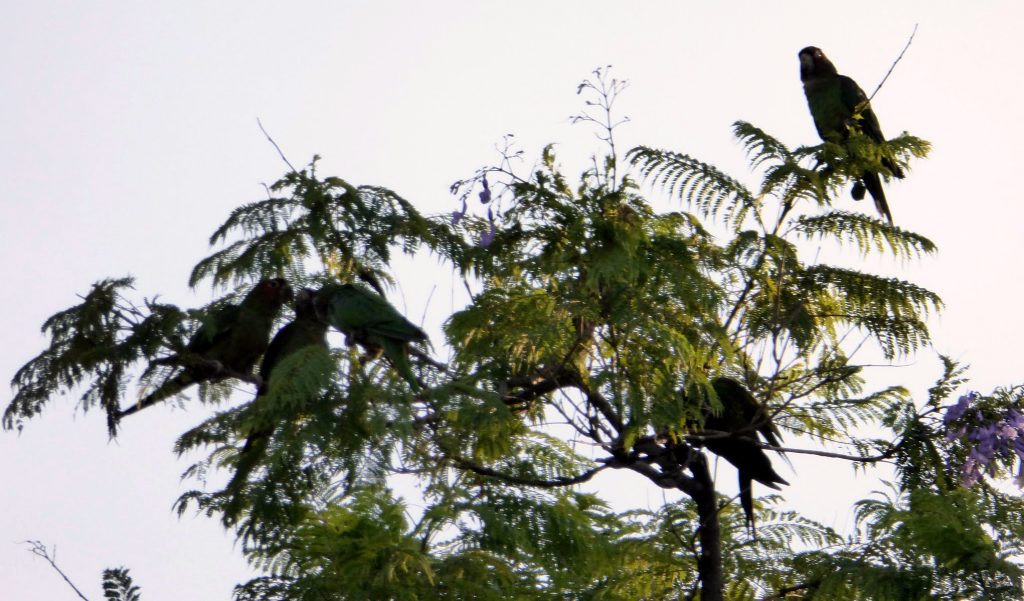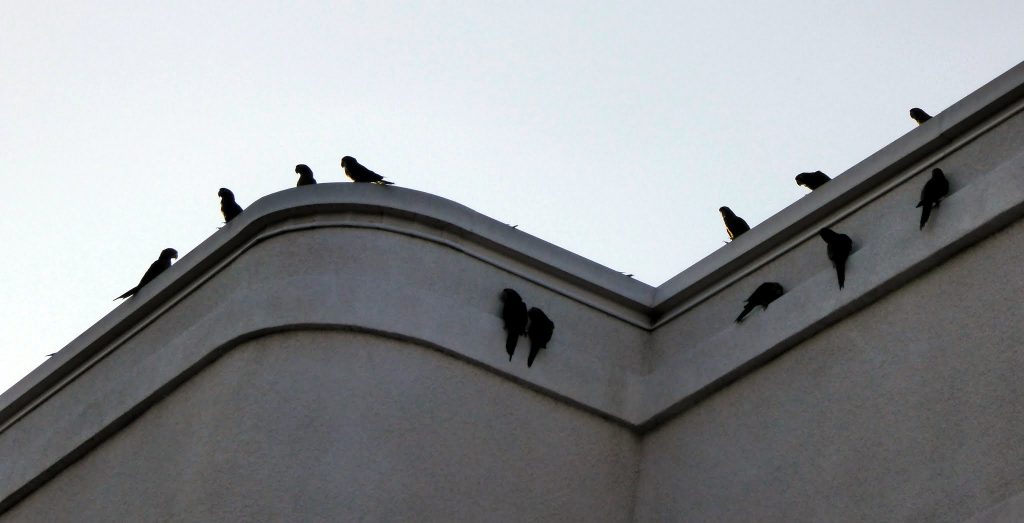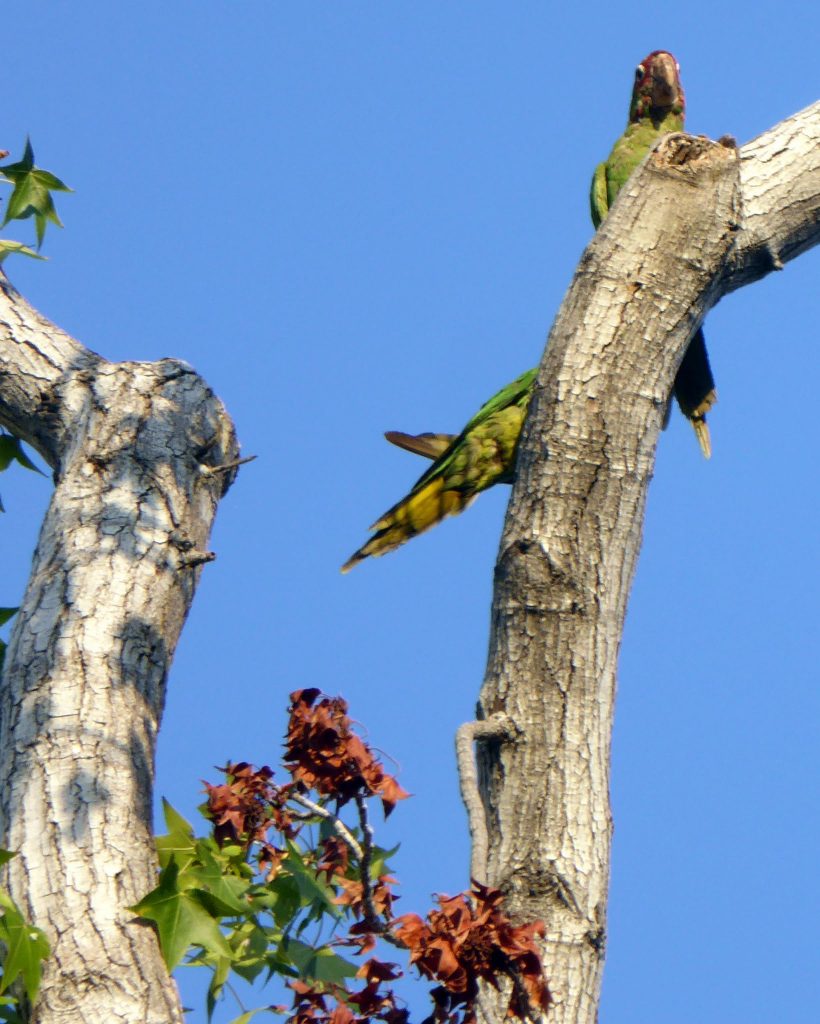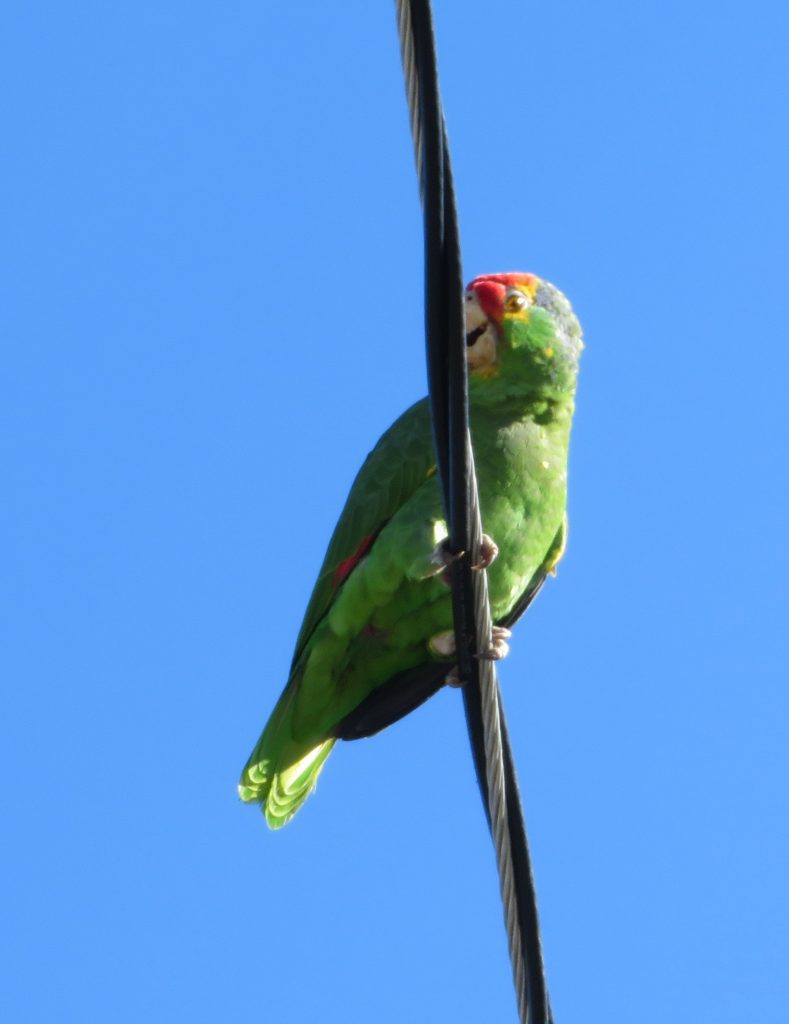“The sound of birds stops the noise in my mind.”
~ Carly Simon
Last spring, we saw this guy on the way to an early morning Benji soccer game. Loud and proud, he announced his presence behind Rosemont Middle School in La Crescenta.

When I asked my “friends” where they see wild parrots in Southern California, the length and breadth and diversity of places, spottings, and opinions surprised me.
I love these guys and wanted to learn all about them.
Here’s a delightful twelve minutes showing all of the species of parrots found in our neighborhoods produced by Salvatore Angius.
They’re everywhere.
“From San Francisco to South Florida, populations of nonnative parrots—some imperiled in their tropical homelands—are thriving in U.S. cities and suburbs.”
“All the nonnative parrots are escaped pets or descendants of escapees. Parrots are found in the greatest numbers in parts of South Florida and California with large numbers of exotic plants—imported and watered by humans—that produce fruit, seeds and flowers year-round. ‘That’s one of the reasons you find parrots in the city rather than in Everglades National Park,’ says Pranty. Some areas of South Florida may in fact have a greater diversity of parrot species in a smaller area than anywhere else on Earth.”
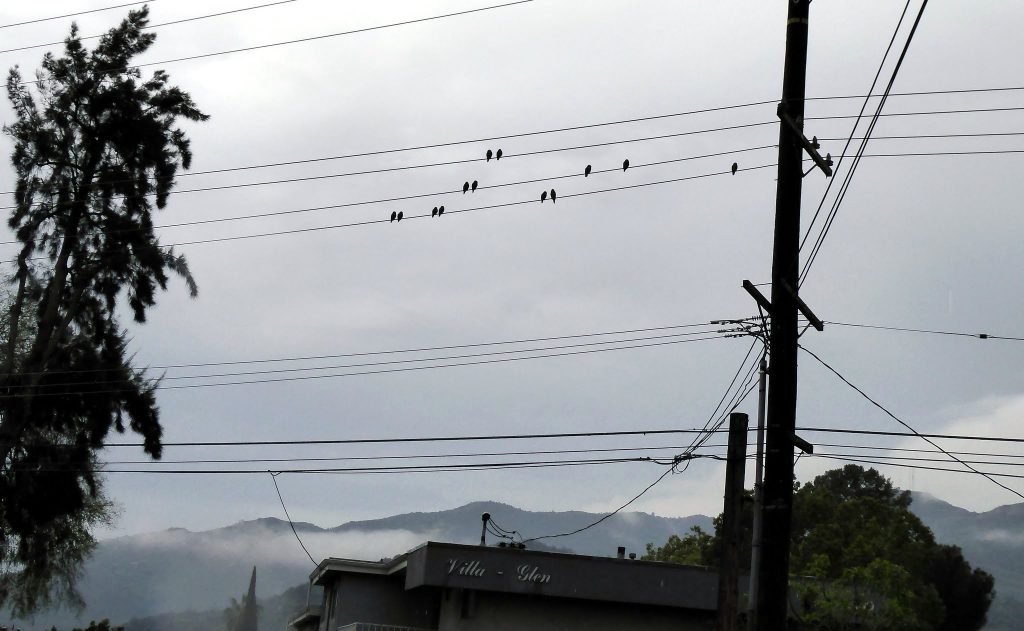
“There are 372 species of parrots/parakeets that have been identified worldwide, mostly living in tropical and subtropical regions. In their native habitats, some of these species are becoming endangered, due to a combination of decreasing habitat and the once extensive pet parrot trade. Many of the countries that imported parrots now host thriving flocks in the wild, including the United States.
In Southern California, there are at least 11 species of wild parrots inhabiting at least 35 cities (see our list below). Ten of those species came from the jungles of Latin America, one came from India/North Africa. None came from Australia or New Zealand, which also have native parrots. All came to SoCal via the imported pet trade.
[T]here are at least four plausible theories that explain how the wild parrot population started in Southern California:
- There are verified reports of small bird traders in the 1940s and ’50s who had accidents en route and let their wild-caught, caged parrots free without meaning to.
- In 1959, parrots were released from Simpson’s Garden Town Nursery on the east side of Pasadena when it caught fire. Rather than watch 65 – 70 birds in the pet shop burn up, an injured employee, with the help of firefighters, freed as many as he could.
- In the San Fernando Valley, parrots are said to have been released in 1979 by Busch Gardens — an exotic tourist attraction theme park set up by Anheuser Busch to draw the public to their Van Nuys beer manufacturing facility. When the company moved its headquarters to a different location, they attempted to place their collection of birds in zoos and private homes, setting free those they were unable to place.
- Most of California’s pet parrots showed up during a time when importing parrots was still legal — approximately 41,550 in the early ’80s, according to Long Beach’s Press Telegram News (08/22/13). However, as some parrot species became endangered in their home countries, their importation became illegal, and smugglers are said to have released parrots to avoid being caught.
They’re loud!
“Now called ‘California wild parrots,’ the burgeoning bird population has gone native. Their ancestors were trapped in the tropical forests of South America and Africa and sold here as pets before an importation ban went into effect in the 1980s – and illegally afterward.
How exactly they escaped their cages is speculation. Individual jail breaks seem likely. The 1961 Bel Air fire may have spurred homeowners to free mass numbers of beloved birds rather than see them die in flames. Some birders also credit the closing of the Busch Gardens aviary in Van Nuys with fueling their numbers. Now they are reproducing in ‘the wild.’
And like the other kazillion transplants in L.A., they fell in love with the California lifestyle.
‘They’re commuters. They’re extremely social. That’s why they fly in large numbers,’ Garrett said. ‘They fly long distances to find food yet can be very loud and heard from far. Most of them don’t cause much harm’ to our local environment.
Most L.A. transplants come for glittery lights of Hollywood and the dreams of opportunity. Few ‘make it’ as well as the parrot has.”
“The parrots can be spotted virtually throughout Southern California, however flocks have been known to frequent particular areas. High concentrations have been reported in Pasadena, Arcadia, Redlands, Riverside, San Bernardino, Malibu, Palos Verdes, Van Nuys, Northridge, Bel Air, Brentwood, San Gabriel Valley, Ventura, Redondo Beach, Long Beach, and San Diego. The best time for viewing is around sunset in the winter months when flocks congregate at roosting sites.”
“Her name was Lola. No, not L-O-L-A, Lola, from the Kinks’ song, but a Mexican Redhead.
Well, actually, not that either, it turned out.
‘We don’t really say that anymore,’ the avian veterinarian said as he helped Lola out of her carrier. ‘She’s an Amazon. A green-cheeked Amazon, Amazona viridigenalis. That’s what the scientific name means. Though most people just call them red-crowned parrots.’
Some discussions are already underway on how we might translate such a vision into reality: reintroducing native oaks and sages, for example, while providing space for community gardens, full of plants brought to Los Angeles from around the world; reconciling respect for the lives of feral cats with the protection of urban birds; and balancing the need for more affordable housing with the desire for more green spaces in urban areas that don’t have enough of either.
Turning the city into a multispecies sanctuary should be part of these discussions – not only because the city is already functioning in this way for species like the red-crowned parrots, but also because other humans and nonhumans might need our ‘urban ark’ in the future.”
“The California Parrot Project, a website about ‘naturalized’ parrots, provides information about 13 different species of birds that fly over the ‘urban jungles’ of California. The one thing all these parrots have in common is that they are loud:
‘Their voices are used in playful jousts and territorial displays; they will announce their arrival and departure their desire to communicate is at the core of their very being. Though some calls are unique to a specific species, there are calls that have proven to bridge the species barrier. In short, a parrot is not a parrot without a voice.’
Everything I know, I learned from the folks at So Cal Parrot who’ve shared the best FAQ (and rescue parrots, if need be.)
“’Why is it that we can so easily celebrate parrots imported from Ecuador but that nobody knows what a bushtit is?’ Clark says. ‘Why do we have a movie about the parrots of Telegraph Hill but not a movie about the brown creepers of Golden Gate Park or the snowy plovers of Ocean Beach? I’ll tell you — it’s because the parrots are like the only species people know of the 175 that live in San Francisco.’”
“’Most of these parrots are endangered in their native ranges, but are thriving here in this new, urban habitat we’ve created,’ Ortiz said. ‘Urban places, like San Diego, may be one of the last locations these endangered parrots may be found if their populations continue to dwindle in their native ranges.’”
“I love them. I love to wake up to them in the morning. I love seeing them in our trees. It’s just, it’s part of nature. It’s part of the community,” Easton said.
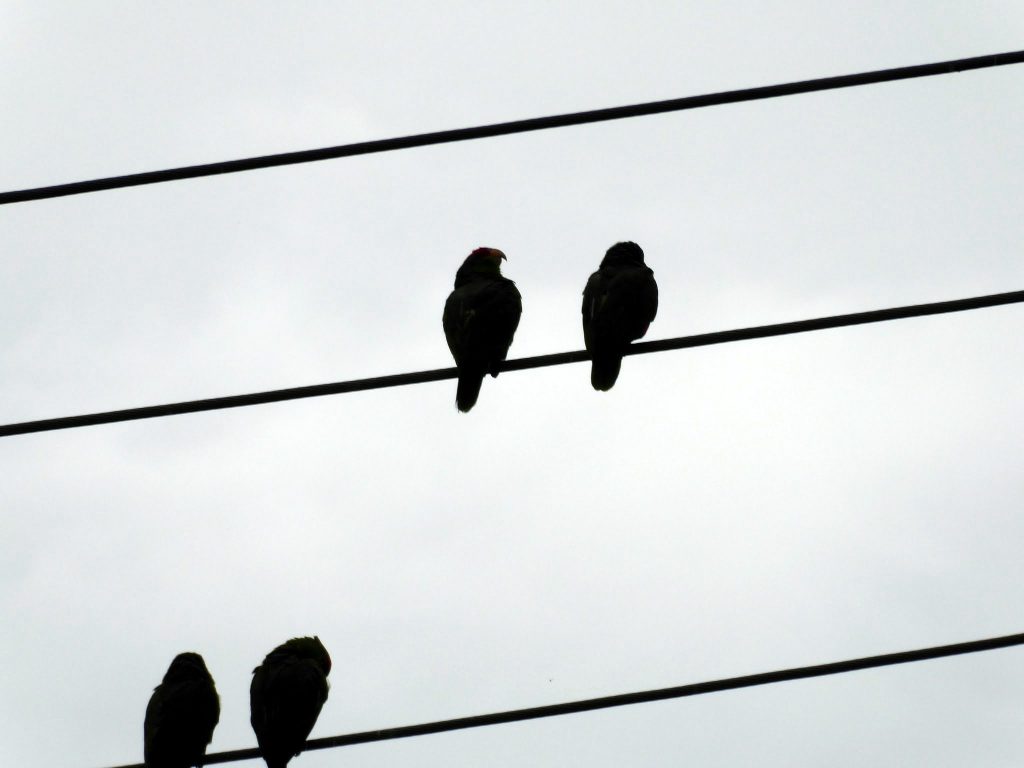
Places we’ve seen parrots:
South Pasadena
440 Mission St
Near Middle School
South LA
Jefferson & Western
West Adams (Dolores)
Lafayette Square
Esme’s pecan tree
LA Zoo (over)
Koreatown
Mid-City
Windsor Square – near Getty House in the Queen Anne palms planted in the 1920s
El Sereno
Cypress Park
Cahuenga Pass
West Adams
Eagle Rock
Venice
Like to eat the Canary Island date palms
La Crescenta
Burbank
North Shelton Street
S/E corner of Altadena near Eaton Canyon (peacocks there too)
Redlands
Riverside
San Bernardino
Santa Monica
North of Montana
West Hollywood
City Hall
Westwood
Bel Air
Brentwood
Beverly Hills
Will Rogers Memorial Park
Redondo Beach
Long Beach
(traffic circle – back & forth Belmont Shore + LB Bluff Heights (Nikki)
Sylmar
Granada Hills
Van Nuys
Northridge
Sherman Oaks
Tujunga
Commerce/Apperson
North Hollywood
Malibu
Palos Verdes
Whittier
Whittier Narrows
West Covina
Near WCHS
Covina
Arcadia
Near racetrack
Alhambra
San Gabriel
Pico Rivera
Azusa
San Gabriel
Cerritos Towne Center in the palm trees next to the movie theater
San Pedro
Altadena
E. Pine St near Fair Oaks
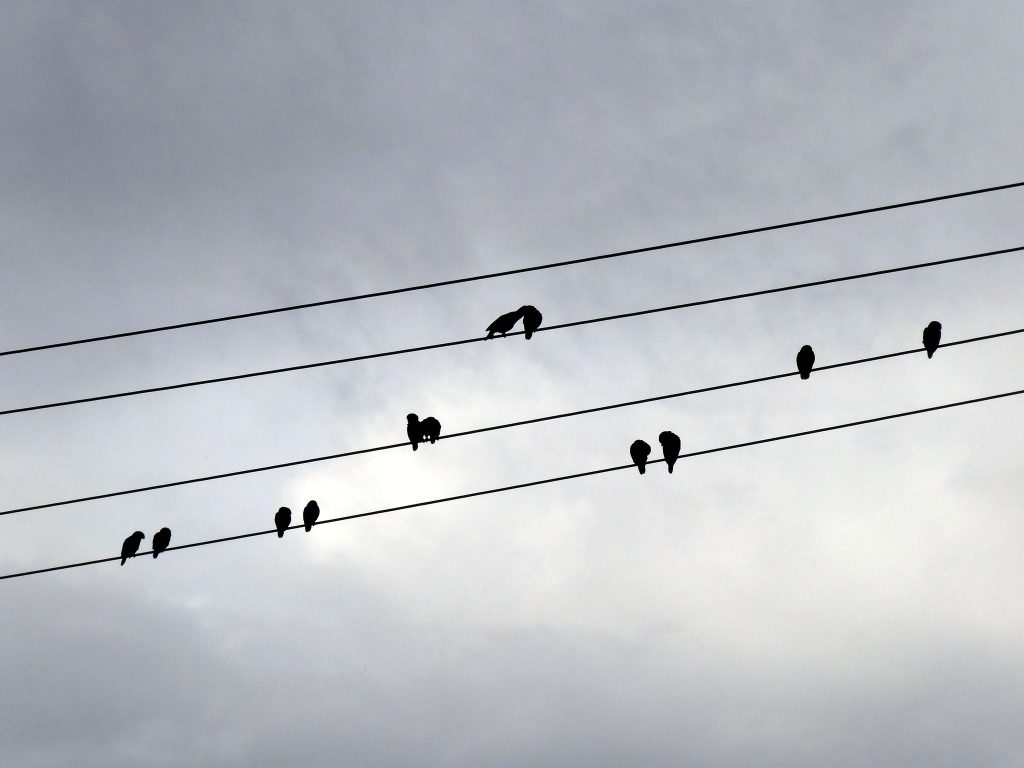
Bonus parrot points:
Biologist Karl Berg asks the question, ‘How do parrots learn their names?’ Are they genetically encoded or are the learned from their parents?

